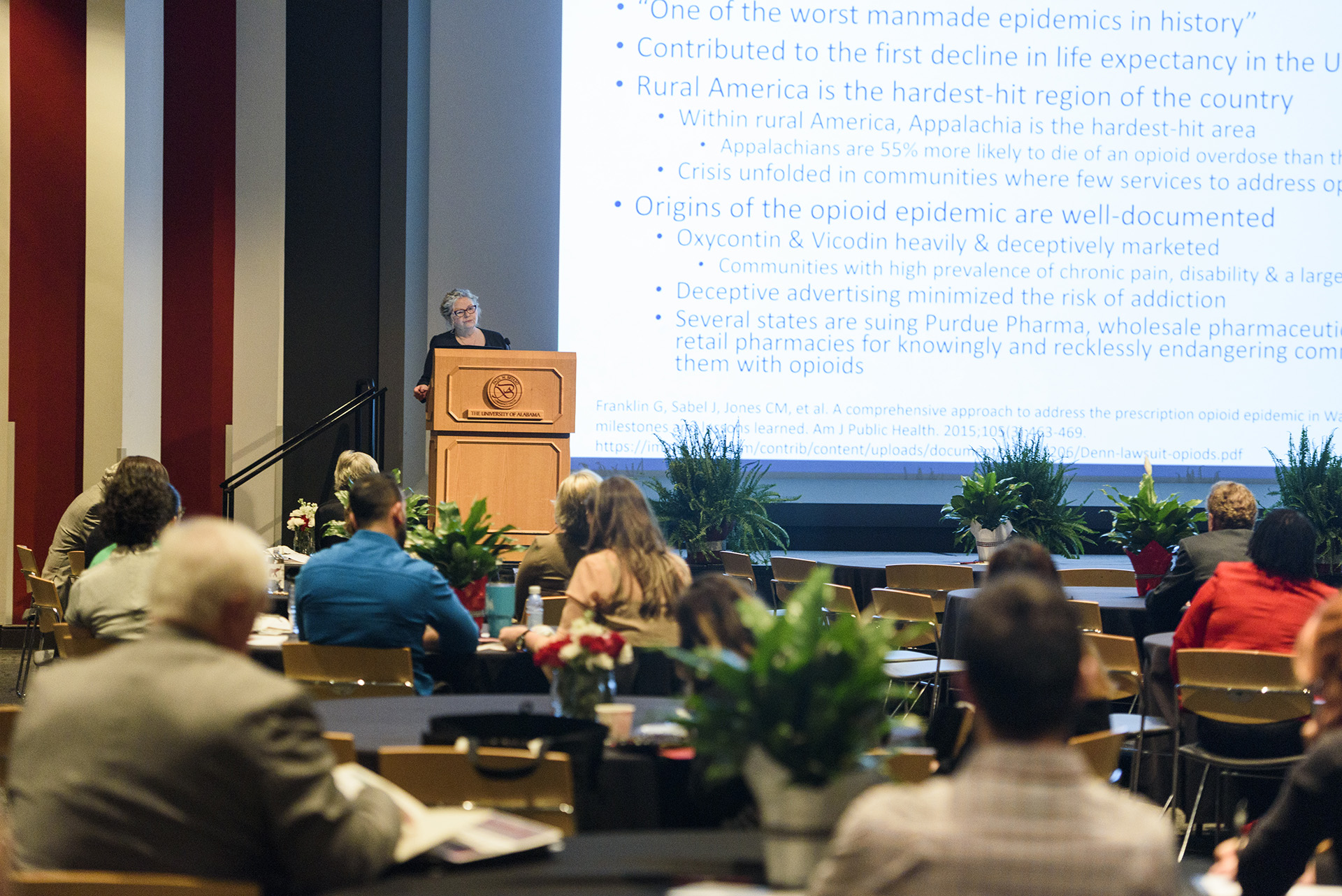Substance abuse in Alabama and the US was the topic of the 19th Annual Rural Health Conference held April 25-26 at the Bryant Conference Center on The University of Alabama campus. The annual Rural Health Conference is hosted by the College of Community Health Sciences and its Institute for Rural Health Research.
This year’s conference, “Substance Abuse in Alabama: When it Hits Home,” featured several keynote speakers, as well as breakout sessions and a community resource panel. Below are highlights from the keynote addresses.
The annual Rural Health Conference is attended by health care professionals, community leaders, researchers, government officials and policymakers working together to share information and knowledge and make a difference in the health of rural communities.
Dr. Holly Hagan, professor, New York University’s Rory Meyers College of Nursing; co-director, NIH Center for Drug Use and HIV Research:
In 2016, there were more than 64,000 drug overdose deaths, exceeding motor vehicle accident and gun fatalities. “And there are no signs of it leveling off. We can expect to see increases over time. Opioids are heavily and deceptively marketed in areas with a high prevalence of chronic pain and a large manual workforce.” The immediate consequences of the US opioid crisis are overdoses and deaths, neonatal abstinence syndrome, and an increase in rates of Hepatitis C, HIV, and sexually transmitted infections. Longer-term consequences include lifelong struggles for individuals with opioid use disorder, stress in families and communities, a negative impact to the workforce, incarceration and stigmatization. The total cost of the US opioid epidemic in 2015 was $500 billion.
Stephanie McCladdie, director, Substance Abuse and Mental Health Services Region 4, Atlanta; director, Prevention Services, Alabama Department of Mental Health:
Factors that contribute to substance abuse in rural America include poverty, unemployment, poor education, high-risk behaviors and isolation. For rural Americans with substance abuse issues, drug treatment and behavioral health services are not readily available, and rural hospital emergency room personnel and first responders have limited experience caring for patients suffering from drug disorders or overdoses. “Substance abuse can be especially hard to combat in rural areas due to limited resources for prevention, treatment and recovery.” There are 2.1 million people in the US with an opioid use disorder, but only 20 percent receive addiction treatment. What’s needed? Strong public health surveillance, improved practice of pain management, increased access to treatment and recovery services, and support for cutting-edge research. “There’s an urgent need to prepare the workforce to deliver treatment and recovery services.”
Dr. Richard Spoth, F. Wendell Miller Senior Prevention Scientist; director of Partnership in Prevention Science Institute, Iowa State University:
In rural areas, one-half of adults say they have been directly affected by the opioid crisis. “They’ve lost a family member, used or abused themselves, or they know someone who has. This is when it hits home.” Still, in 85 percent of US rural counties, behavioral health and prevention services are sparse or non-existent, and opioid and other drug problems continue to escalate. “We need to build on accessible infrastructure and resources – public school systems, extension services and public health programs. And we need evidence-based interventions off the shelf and into the hands of people who need it.”
Dr. Stefan Kertesz, professor, UAB Division of Preventive Medicine:
Opioids accounted for two-thirds of drug overdoses in 2016, and many overdose deaths involve multiple substances, including synthetic opioids. The Centers for Medicare & Medicaid Services (CMS) implemented a prescription dose limit for 2018 that requires insurers to deny payments to patients prescribed a total morphine equivalent of 90mg. This proposal is designed to reduce older individuals’ risk of becoming addicted to or overusing opioids, and ultimately to reduce the oversupply of the drugs. But, most overdose deaths are happening in people who are receiving a low-dose prescription. “We don’t fully understand the event we call overdose if most of the problem is happening at a low dose.” Overdoses occur primarily among tolerant older users, and most deaths involve people using multiple drugs… Overdose is more like a poisoning event.” As opioid prescriptions are limited, those addicted turn to other drugs like heroin or fentanyl to fill the gap. The CMS prescription limit faces clinicians with an ethical dilemma: “Do we take nonconsensual action on patients who are adherent and stable, and there is absent strong evidence for those actions that sometimes result in the patient’s death?”
